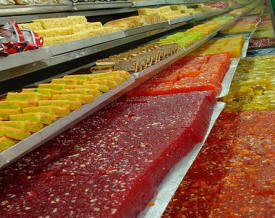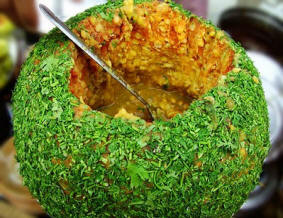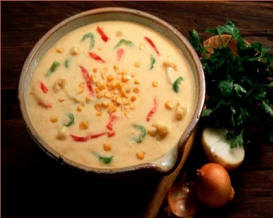Several customs are associated with the manner of food consumption.
Traditionally, meals are eaten while seated either on the floor or on very
low stools or cushions. Food is most often eaten without cutlery, using
instead the fingers of the right hand. However, these traditional ways of
dining are being influenced by eating styles from other parts of the world.
Traditional serving styles vary from region to region in
India. A universal aspect of presentation is the thali, a large plate with
samplings of different regional dishes accompanied by raita, breads such as
naan, puri, or roti, and rice.
In South India, a cleaned banana leaf is
often used as a hygienic, visually interesting and environmentally friendly,
alternative to plates.
Less silver more hand
Though Indian cooking uses an extensive array of
specialized utensils for various purposes, Indians traditionally do not use
cutlery for eating, as many foods - such as Indian breads and curry - are
best enjoyed when eating with the hand.
There is a story that the Shah of Iran, on a visit to India, was so impressed by the custom that he remarked
that to eat with a spoon and fork is like making love through an
interpreter. Indians usually give the following explanation for the practice
of eating with hands: "Food is divine and needs to be enjoyed with touch,
smell and taste. There is no joy in using a knife and fork to eat it."
We bring taste of India to you.
We provide exquisite home made food for small gatherings or large parties as per your need. Contact us for details.
Eating with your hands is considered important in Indian etiquette because a
person eating with his hands knows the exact temperature of food before the
morsel hits his mouth thus preventing blisters in mouth due to consumption
of hot food.
How to eat Indian food without silver
Eating with one's hands is a technique that can be quite
clean when done correctly, but may require a degree of practice. First, the
hands must be thoroughly washed, with particular attention paid to the
fingernails. Having long fingernails in India is considered unhygienic (with
the exception of sadhus and other ascetics).
Using the fingers, the food should be scooped onto the
flatbread (naan, roti, etc.) and quickly brought to the mouth. In North
India, when eating curry, the gravy must not be allowed to stain your
fingers--only the fingertips are used.
In South India, it is considered ill
mannered to let your food stain the out side of your fingers or palm while
eating and food is to be eaten only with the tip of the fingers, though
popular belief is to think it is okay use more of your hand. In South India,
the plate is not to be touched or held by the left hand while eating.
When flatbreads such as chapati, roti, or naan are
served with the meal, it is acceptable to use pieces of them to gather food
and soup up gravies and curries.

~:~ Indian Desserts ~ Thousands of varieties ~:~

~: Mouth watering snacks Ragda and Pani-puri :~

~:~ Addendum to any meal - raita ~:~
Be careful
However, not all Indian foods should be eaten with the hands,
If the food is "wet" or "watery," like many daals and soups, spoons
should be used. Additionally, foods such as rice are traditionally eaten
with spoons in both North and South India, though this can vary depending
upon the region.
Additionally, spoons (usually two used in a clasping
motion) and forks are commonly used to distribute foods from a communal
dish, as it is considered rude to touch the foods of others.
Traditional Indian cutlery does not recognize the use of
forks and knives while eating, limiting their use to the kitchen only.
Spoons were made of wood in ancient times, evolving into metallic spoons
during the advent of the use of the thali, the traditional dish on which
Indian food is served.
~:~:~:~:~:~:~:~:~
Respect
Like many other forms,
food is also considered a form of God in India. It is
given due respect.
Food item fallen in the ground is not stepped on. In
formal settings, it is expected that everyone will wait for the host or the
eldest person (the elder taking priority over the host) to begin eating
before everyone else starts.
Everyone must wash their hands before sitting
at the table as some Indian foods are eaten by hand. One must wash one's
hands after eating the food. It is not necessary to taste each and every
dish prepared; but you must finish everything on the plate as it is
considered a respect for served food. So, take only as much
food on the plate you can finish.
Share your recipes
Visit 'Main course', 'Desserts' and other section of this site for recipes.
If you have skills in cooking and want to share your creation with the world, please
Contact us.